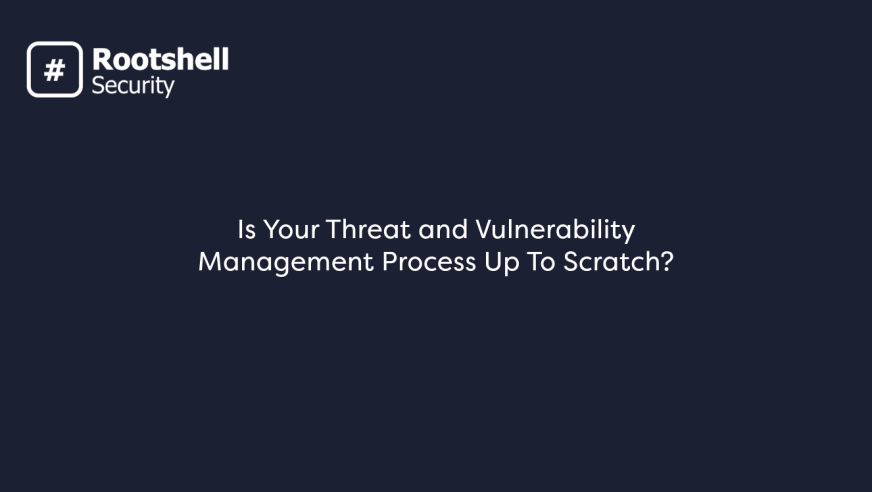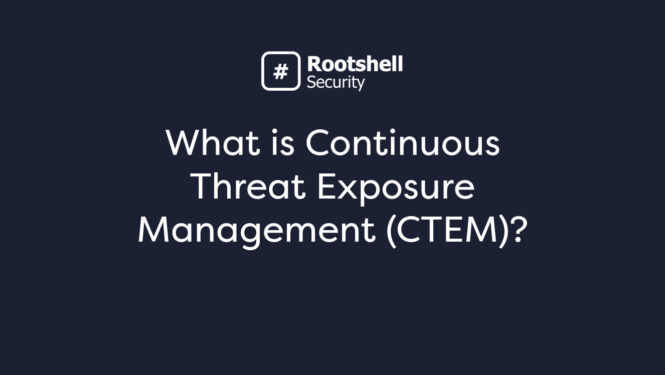- Threat and vulnerability management involves identifying, analysing, prioritizing, and remediating weaknesses in an organization’s network.
- Ensuring that threat and vulnerability management is delivered in line with best practice enables teams to prioritize effectively and resolve critical issues as fast and efficiently as possible.
- Threat and vulnerability management solutions like The Rootshell Platform help IT security teams modernize their processes and remediate most effectively.
What is Threat and Vulnerability Management?
Threat and vulnerability management is the process of identifying, analysing, prioritizing, and resolving security issues and incidents that could lead to the breach of an organization.
The goal of threat and vulnerability management is to ensure that organizations have complete visibility and control of weaknesses that exist within their security postures, so they can minimize their attack surfaces and successfully reduce organizational risk.
Delivering Threat and Vulnerability Management
The Threat and Vulnerability Management Process
Threat and vulnerability management starts with the discovery of security issues, and concludes with validating whether remediation has been successful, before repeating continuously.
Cyber threat intelligence should be gathered and referenced on an ongoing basis to aid the contextualization and prioritization of issues.
- Discover: Identify threats and vulnerabilities within your organization’s network by carrying out regular penetration tests and vulnerability scans.
- Consolidate: Centralize your threat and vulnerability assessment results in one place. Vulnerability management systems can make this process effortless.
- Assess: Analyse your security issues in line with cyber threat intelligence, such as exploit databases, to establish their severity, the likelihood that they will be exploited, and the impact they could have on your organization.
- Prioritize: Assign severity scores to your assets in line with your analysis, and other factors such as resource availability.
- Remediate: Carry out your threat and vulnerability remediation program to resolve vulnerabilities in line with your organization’s priorities.
- Re-assess: Verify whether your remediation efforts have been successful. Ultimately, your threat and vulnerability management remediation process should reduce business risk.
- Visualize and improve: Continuously improve your threat and vulnerability management processes; resolve any bottlenecks and ensure compliance with your organization’s service level agreements. For example, could you reduce your time-to-remediate (TTR)?
Best Practice Threat and Vulnerability Management
Threat and vulnerability management should be continuous, intelligence-led, and streamlined, to enable IT security teams to analyse, prioritize, and remediate most effectively. Consider these vulnerability management best practices when building a vulnerability management program.
Continuous
The time between security assessments is the time when your organization could be at risk. Threat and vulnerability management should be an ongoing process to close these gaps.
Intelligence-led
An intelligence-driven approach to threat and vulnerability management enables IT security teams to gain essential context of their issues, prioritize most effectively, and accurately evaluate risk.
Streamlined
Bottlenecks within threat and vulnerability management processes can lose you precious time. Processes should be streamlined, empowering teams to address issues fast and efficiently.
The Need for a Threat and Vulnerability Management Solution
A threat and vulnerability management solution could be a software, platform, or application that makes it easy for IT security teams to implement effective threat and vulnerability management.
For example, threat & vulnerability management tools could aid prioritizing, delegating, reporting, tracking, and collaborating on remediation.
The Rootshell Platform is our vendor-agnostic threat and vulnerability management solution that combines penetration testing services, vulnerability scanning, and cyber threat intelligence to put you at the centre of your IT security ecosystem and improve remediation from start to finish.

Effective Threat and Vulnerability Management With The Rootshell Platform
Here are just some of the ways The Rootshell Platform makes it effortless to implement effective threat and vulnerability management.
- Centralize security issues: Rootshell is vendor-agnostic, so you can use it to consolidate results from any vulnerability scanner or penetration testing vendor. Managing all your vulnerabilities in one place makes it seamless to continuously analyse, prioritize, and manage all issues across your estate.
- Intelligence-driven prioritization: Rootshell’s industry-leading Daily Exploit Detection alerts you to exploits for your issues on a daily basis, so you can gain the context needed to prioritize most effectively.
- Streamline remediation: The Rootshell Platform modernizes threat and vulnerability management and makes it easy for teams to deliver fast and effective remediation, by reducing manual processes, integrating with ticketing systems, and much more.
- Real-time alerts: Rootshell ensures you have real-time insight into your threat landscape, by providing you with live updates from tests and continuous cyber threat intelligence alerts tailored to your digital estate. Read more on Continuous Vulnerability Management.
Threat Intelligence For Vulnerability Management

Rootshell’s industry-leading Daily Exploit Detection integrates with exploit databases to serve you automated, continuous alerts as soon as an exploit becomes available for an issue within your digital estate.
Frequently Asked Questions About Threat and Vulnerability Management
What is the difference between vulnerability management and vulnerability assessment?
Vulnerability management is not to be confused with a vulnerability assessment. Vulnerability management encompasses the end-to-end process of managing security issues, from discovery to remediation. On the other hand, a vulnerability assessment is a type of IT security test that discovers security issues within an organization’s network.
What is the difference between a penetration test and a vulnerability assessment?
A penetration test simulates a real-world attack on your organization’s network, applications, systems, to identify any weaknesses. A pen test is conducted by skilled consultants, who use the same techniques as real-word hackers; you can think of it as ‘ethical hacking’. On the other hand, vulnerability scanning is carried out using automated tools and solely focuses on identifying vulnerabilities within software.
What is cyber threat intelligence?
Cyber threat intelligence (CTI) enables your organization to understand the potential threats and threat actors looking to perform malicious activities against your brand, employees, and customers. This intelligence can be gathered from a wide range of sources, including exploit databases, open source intelligence from the web, and more.
What are the differences between a vulnerability, a risk, and a threat?
Within threat vulnerability management (TVM), the terms ‘vulnerability’, ‘risk’, and ‘threat’ are sometimes used interchangeably, but they have different meanings.
- Vulnerability: the security weaknesses within an organization’s IT network, e.g. a system misconfiguration
- Threat: incidents that could lead to a breach of an organization, e.g. insufficient phishing training for staff
- Risk: an evaluation of the impact a threat could have, specific to the organization, e.g. a critical asset is at risk



